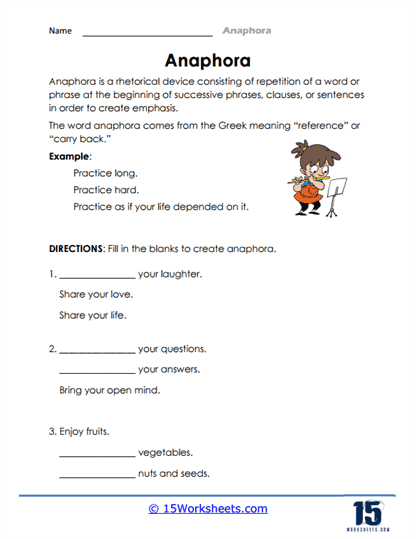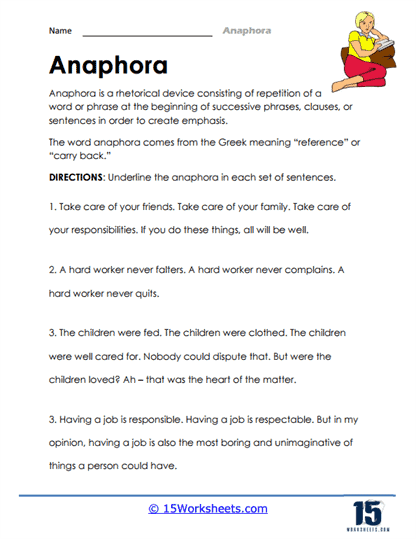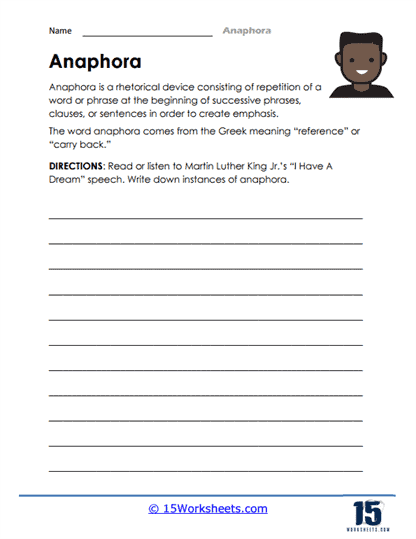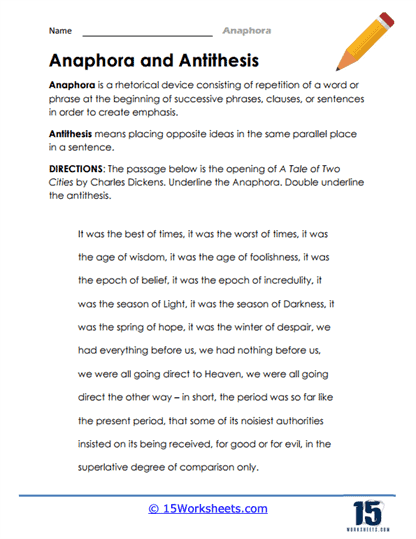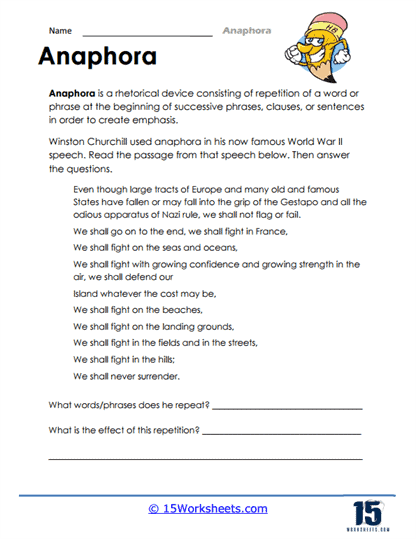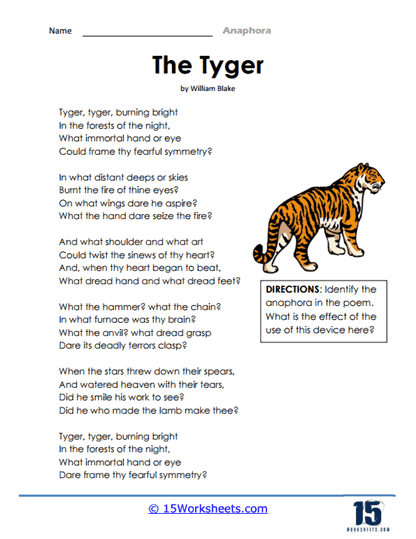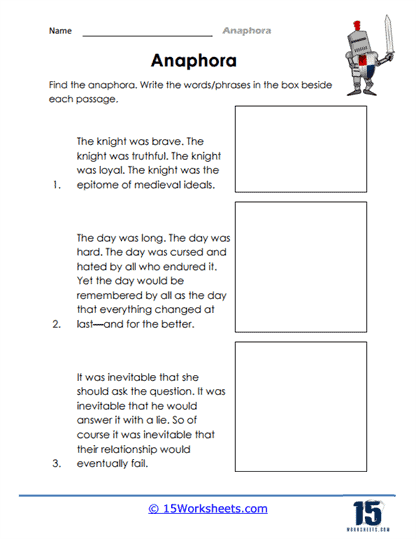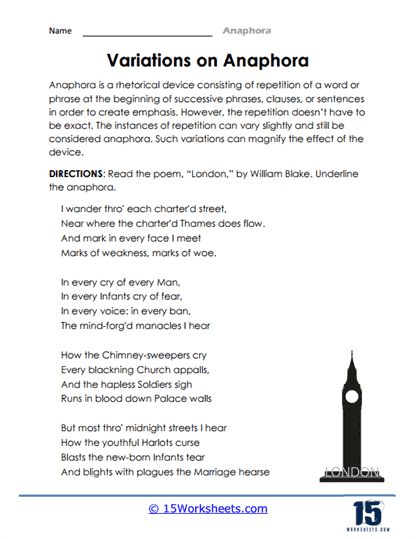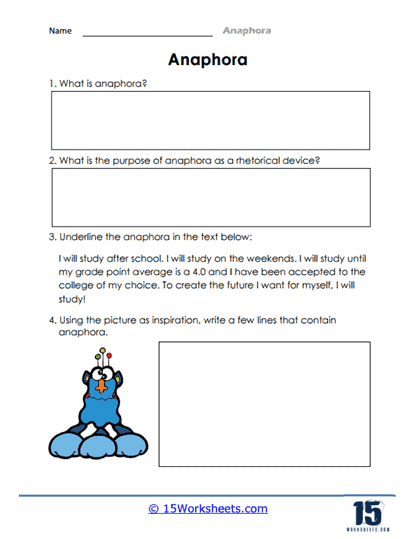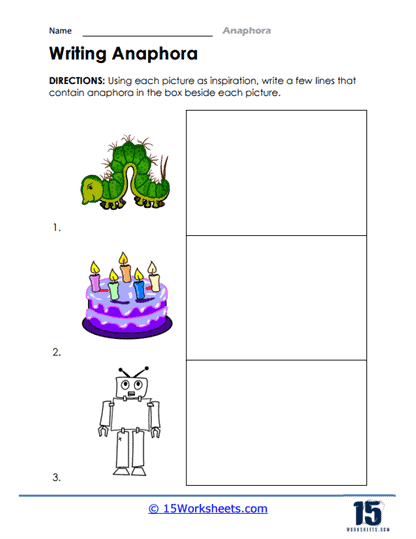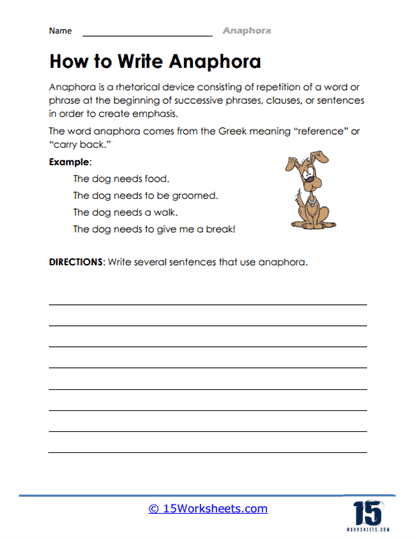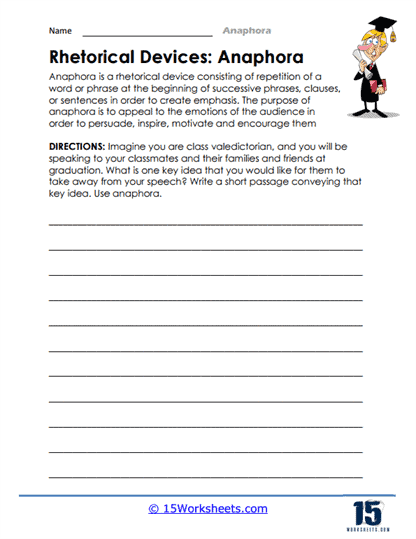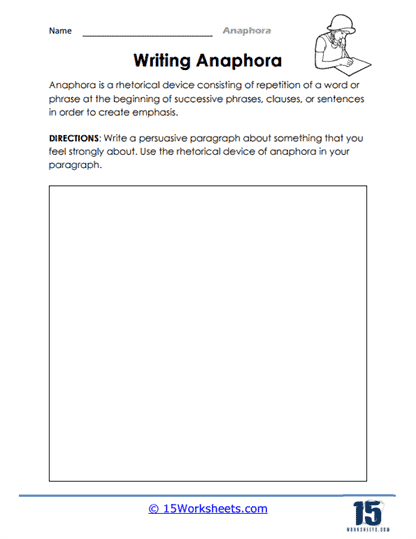Anaphora Worksheets
All About These 15 Worksheets
Anaphora, the rhetorical device that involves the repetition of a word or phrase at the beginning of successive sentences or clauses, is a powerful tool in language and communication. Understanding anaphora not only enriches students’ grasp of literary and persuasive techniques but also enhances their writing and speaking skills.
In an era where effective communication is paramount, students must develop the ability to recognize and employ anaphora for impact. To empower students with the art of anaphora and its myriad applications, we proudly present a collection of 15 worksheets on Anaphora.These worksheets are meticulously designed to provide students with structured and engaging opportunities to explore, practice, and master anaphora.
What Is An Anaphora?
These are worksheets that help you understand and use a special technique in writing called anaphora. Anaphora is when you repeat a word or phrase at the beginning of sentences to make your writing more powerful and memorable.
In these worksheets, you’ll see examples of sentences where the same word or phrase is repeated at the beginning. For example, you might have a sentence like “I have a dream” repeated multiple times. Anaphora worksheets will ask you questions and give you sentences to practice using anaphora yourself.
The goal of anaphora worksheets is to help you improve your writing by using repetition to create emphasis and rhythm. By repeating certain words or phrases, you can make your writing sound more persuasive, poetic, or engaging.
Why Do Authors Use Anaphora As A Literary Device?
Authors use anaphora as a literary device for several reasons. Here are five examples:
Emphasizing Ideas
Anaphora helps authors emphasize key ideas or concepts by repeating them at the beginning of successive sentences or lines. By using anaphora, authors draw attention to these ideas and make them stand out in the reader’s mind. For instance, in Martin Luther King Jr.’s famous speech, he used anaphora with the phrase “I have a dream” to emphasize his vision for equality and justice.
Creating Rhythm and Repetition
Anaphora adds a rhythmic quality to writing, making it more engaging and memorable. By repeating certain words or phrases, authors create a pattern that captures the reader’s attention and makes the writing flow smoothly. In Edgar Allan Poe’s poem “The Raven,” the repetition of “Nevermore” at the beginning of each stanza through anaphora contributes to the poem’s haunting and melodic rhythm.
Evoking Emotional Impact
Anaphora can evoke strong emotions in readers by emphasizing the intensity or significance of certain emotions or experiences. By repeating emotionally charged words or phrases, authors amplify the emotional impact of their writing. In Maya Angelou’s poem “Still I Rise,” the anaphora of “I rise” conveys resilience, strength, and defiance, invoking a powerful emotional response.
Creating a Sense of Unity
Anaphora can unify a piece of writing by linking together related ideas or themes. By repeating a word or phrase, authors establish a connection between different parts of their work, creating cohesion and reinforcing the central message. In Charles Dickens’ novel “A Tale of Two Cities,” the anaphora “It was the best of times, it was the worst of times” highlights the contrasting nature of the time period and underscores the theme of duality.
Enhancing Persuasion and Memorability
Anaphora is often used in persuasive writing to make arguments more convincing and memorable. By repeating persuasive phrases or slogans, authors make their message stick in the reader’s mind. In Winston Churchill’s speech during World War II, he employed anaphora with the phrase “We shall fight” to rally and inspire the audience.
The Importance of Understanding Anaphora For Students
Understanding anaphora and its various forms is of great importance for several reasons:
- Persuasive Communication: Anaphora is a persuasive technique used to emphasize and reinforce key ideas, making it a valuable tool for effective communication.
- Rhetorical Analysis: Recognizing anaphora in speeches, literature, and persuasive writing helps students engage in critical analysis and appreciate the power of language.
- Enhanced Writing Skills: Learning to use anaphora in their own writing allows students to create impactful and memorable compositions.
- Public Speaking: Mastery of anaphora aids in public speaking by enabling students to employ repetition for emphasis and engagement.
This colletcion of Anaphora worksheets is a valuable resource for educators and parents committed to nurturing effective communication, critical thinking, and persuasive writing skills in students. Proficiency in recognizing and employing anaphora equips individuals with the tools to engage their audience, convey ideas persuasively, and appreciate the artistry of language.
This collection is an investment in their future success, ensuring they have the language skills to communicate with impact and conviction. Embrace the “Anaphora” collection today, and watch your students become masterful communicators who can anchor ideas with precision and persuasion.

